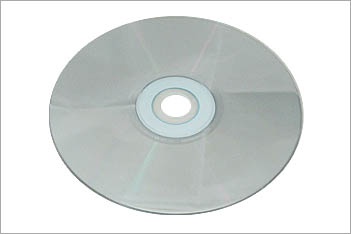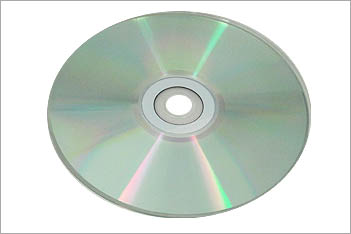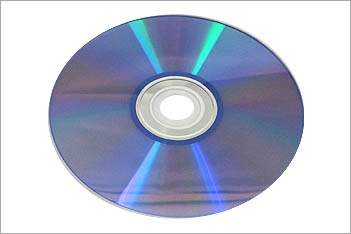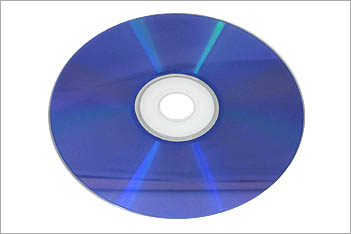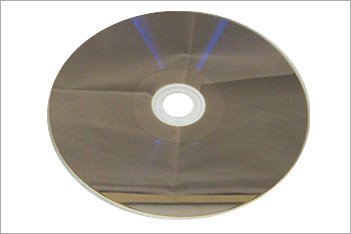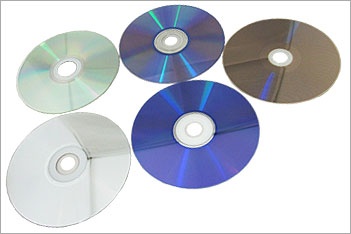Glossary: Types of CD, DVD and Blu-ray
Optical disc is the generic term when referring to a CD, DVD, Blu-ray or other storage medium which requires light to read or write data to. Optical discs come with a plethora of acronyms and abbreviations associated with each type of disc.
Below, we’ll look at what these terms mean, and decipher the jargon, to offer you a straightforward guide. By the end of this guide, you’ll be able to identify any type of optical disc, and know its main uses.
CD / CD-ROM
CD stands for Compact Disc, and ROM stands for Read Only Memory.
This type of disc is supplied pre-pressed with content, which can be in the form of music, data or video. Once the disc is created it cannot be re-written to.
Most CD-ROMs do not have any identifying logos, unless it is included in the design of the CD printing. However, a CD-ROM can be distinguished from other types of CD formats, as the bottom of the disc is fully silver and it is quite difficult to make out a difference in shades between the written data section of the disc and the section that remains data free.
CD-R
A CD-R is a writable disc (the R stands for Recordable).
This type of disc can have data burnt to it only once. If the disc is not finalised or closed with burning, then additional content can be added to the disc, until it reaches its full capacity.
A CD-R does not allow for existing content to be deleted off the disc.
CD-R 74 / 80 / 90 / 99
You may find the CD-Rs in your collection to contain one of the above numbers after the CD-R acronym. These numbers refer to the length of uncompressed audio that can be written to the disc in minutes.
74 minutes is the industry standard which can contain about 630MB of data. An 80 minutes CD-R can hold about 703MB of data, a 90 minute about 790MB, and 870MB for a 99 minute CD-R.
When burning a 90 or 99 minute CD-R, most writing software need to be told to ‘overburn’ the disc, in order to take advantage of the additional capacity.
A disc that contains more than 76 minutes of data cannot be guaranteed to play in all CD players, although most new players should recognise the CD without an issue.
CD-RW
The RW stands for Re-Writeable.
This type of disc can have data added to it, and once the data is no longer required, this can be deleted and new data added. In this way, the disc can be re-used and data can be re-written to up to 1000 times.
A CD-RW can be compared to a flash drive whereby the content can be wiped and then re-written with new data.
DVD / DVD-ROM (DVD-5)
DVD stands for Digital Versatile Disc, with ROM being an abbreviation for Read Only Memory.
A DVD-ROM is supplied pre-pressed, usually as DVD-video, although other formats are available.
A DVD-ROM has a silver data side, whereas DVD-Rs have a purple dye data side. A DVD-ROM has 4.7GB of capacity, almost 7 times that of a standard CD.
DVD-R / DVD+R (DVD-5)
The R in DVD-R stands for writable.
Early DVD writers were able to write only the -R or +R format, as manufacturers were split on which format to support. One group of manufacturers is known as the DVD forum, made up of Mitsubishi, Hitachi, Time Warner and Sony, who support DVD-R. The other group, who support the +R format, are the DVD+RW Alliance, consisting of Sony, Yamaha, Philips and Dell.
These days all modern writers support both types of DVD format. There are small technical differences in that the +R format allows for features such as a faster disc eject compared to -R, or additional menu functions, but these differences are negligible in the wider scope of things. Both types of disc offer 4.7GB of storage.
For submitting a master for DVD replication there’s no single preferred format, both of the above formats can be provided as a master source for conversion to a DVD glass-master and stamper.
The easiest way to tell the difference between a DVD-ROM and DVD R is that a DVD-R or +R has a purple data side dye, whereas a replicated DVD-ROM is silver on the data side.
M-Disc DVD+R
Whilst comparing the different DVD types, it is also worth mentioning the quite unique M-Disc DVD.
Made out of a rock-like data layer, the disc is designed to last for 1000 years. It has even been military tested to withstand the very toughest conditions.
The M-Disc has been designed to be read in standard DVD drives, however it cannot be written in a standard DVD burner, and requires a dedicated drive called the M-DISC READY™ writing drive.
DVD-RW and DVD+RW (DVD-5)
The RW stands for Re-Writable, and it works in the same way as a CD-RW.
The user can store data to the disc one time or over a period of time, and can delete data and replace it with new content as required.
A DVD-RW has a thicker coating so it can withstand more wear and tear, and is rated for up to 1000 write operations.
The RW format has a storage capacity of 4.7GB.
DVD-RAM
A DVD-RAM (Random Access Memory), has the same functionality as a +RW or -RW, however, it has a lifetime rating of 30 years or more, and a possible 10000 erase or delete operations to the data on the disc. It offers a more secure storage of data, with fewer chances of the data becoming corrupt over time.
DVD-DL (DVD-9)
The DL stands for dual layer.
This type of DVD of disc has almost double the storage capacity of a DVD-5 format, with a total space availability of 8.5GB. Physically, a DVD-9 disc has the same dimensions as a CD or DVD-5, but has a thicker protective lacquer coating to protect the data side.
All the above discussed formats of DVD-5, except the M-DISC, are available as a DVD-9 disc.
DVD-10, DVD-11, DVD-14, DVD-18
These are a rarer format of DVD-ROM, offering larger data storage capacities.
DVD-10, 14, and 18 are discs with two sides of data. An example of this would be a film where the disc needs to be flipped around in the player half way through to access the other half of the content.
These DVDs offer a good piracy deterrent, and are often used with padded out data to offer protection from the content being copied in a direct DVD-to-DVD copy procedure, as re-writeable versions of these discs are not available.
HD-DVD
The HD stands for High Definition, and was launched as a direct competitor to Blu-ray disc.
This format functions just as a DVD disc, but allows up to 30GB of data on a dual layer, and 15GB of data on a single layer. In February 2008 the HD-DVD format was abandoned leaving only Blu-ray as the sole optical disc format for HD.
BD Single Layer / BD Dual Layer
BD is short for Blu-ray Disc.
BD discs are a Read only format, and offer storage capacity of 25GB on a single layer and 50GB on a dual layer disc. The BD-XL format allows for a huge 128GB of data storage on a single disc.
A Blu-ray disc is the ideal format for HD video.
An experimental format of Blu-ray is in development that allows for up to 200GB of data, which will be ideal for storage of the 4K HD format. It is worth noting that current Blu-ray readers and writers do not support the 200GB format as the current drives are not programmed to read the additional data layers found on the disc.
BD-RE
This stands for Blu-ray Disc Rewriteable. It has the same functionality as a DVD+RW or -RW but with the above mentioned storage capacity of 25GB or 50GB. The data can be written and erased as required.
What discs are used for replication?
When a disc is replicated, the finished form is identified with the ROM extension, which stands for Read Only Memory. A replicated CD, DVD, or Blu-ray is created in an injection moulding process rather than data being burnt to the disc with a laser.
View our full range of CD duplication and replication packaging options.
What discs are used for duplication?
For duplication, any of the other mentioned formats, apart from ROM, can be used for DVD, Blu-ray or CD duplication. However, the majority of duplicated discs are recordable (R’s), and are created and finalised in Blu-ray, DVD or CD duplicator towers.
The above image [Fig 6] depicts the data layer of popular disc formats, and on head to head comparision it is quite clear and easy to identify different types of optical discs from the colour of the discs data surface.
As with most things, a variety of quality is available, however to minimise chances of any data corruption it is advised to use grade A discs.
Browse our selection of DVD and Blu-ray duplication and replication options.
